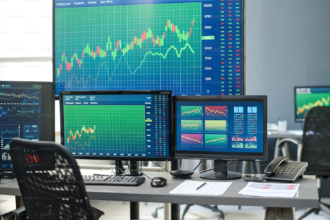Why does gold maintain its appeal as a dependable investment during turmoil? How can it protect wealth while other assets falter? These are pressing questions for investors looking to safeguard their finances during economic instability.
- What Makes Precious Metal a Safe-Haven Asset?
- Economic Indicators That Boost The Demand for Precious Metal
- How Gold Diversifies Investment Portfolios
- The Role of Geopolitical Events in Gold’s Stability
- Practical Strategies for Trading Gold During Uncertain Times
- Why Choose a Reliable Platform for Gold Transaction?
Gold trading has long been viewed as a reliable strategy for preserving value. It becomes a preferred choice for diversifying portfolios and mitigating risk during economic uncertainty. By understanding its role as a safe-haven asset, investors can confidently navigate market volatility.
What Makes Precious Metal a Safe-Haven Asset?
One of gold’s defining characteristics is its ability to retain value over time. Unlike paper currencies, precious metal is not directly influenced by interest rates or monetary policies, making it a reliable hedge against economic disruptions. Historically, investors turn to gold for its stability during financial crises or inflationary pressures.
Gold’s finite supply and universal demand further solidify its position as a dependable store of wealth. This enduring trust in precious metals enables them to buffer against market unpredictability. Additionally, precious metals are globally recognised, making them versatile assets. Their universal appeal ensures they remain in demand across diverse economies, even during turbulent times.
Economic Indicators That Boost The Demand for Precious Metal
Several economic factors drive the demand for precious metals, particularly during periods of uncertainty. Understanding these indicators can help investors identify the best opportunities to incorporate precious metals into their portfolios.
1. Inflationary Trends
Gold is commonly viewed as a safeguard against inflation. When inflation rises, fiat currency’s purchasing power diminishes, prompting investors to seek physical assets like gold to safeguard their wealth.
2. Weakening Currencies
A depreciation in currency value, particularly the US dollar, often enhances the attractiveness of precious metals. As the dollar weakens, precious metals become cheaper for holders of other currencies, increasing global demand.
3. Stock Market Volatility
When equity markets experience significant fluctuations, precious metals often rise in value as investors look for more stable alternatives. This makes precious metals an attractive option during market downturns. By closely monitoring these economic signals, traders can make informed decisions about when to buy or sell precious metals.
How Gold Diversifies Investment Portfolios
Diversification is a key strategy for managing risk, and precious metals are essential in creating a balanced portfolio. Unlike stocks or bonds, precious metals typically move independently of other asset classes. During economic downturns, their value often increases while equities decline, counterbalancing losses in other investments.
Gold also enhances liquidity within a portfolio. It can be easily bought or sold in global markets, ensuring investors can quickly access cash when needed. Including precious metals in an investment strategy helps reduce overall volatility, providing stability during uncertain times.
The Role of Geopolitical Events in Gold’s Stability
Geopolitical tensions often increase the appeal of precious metals as investors seek refuge in safe assets. Situations such as trade disputes, political unrest, or military conflicts can create a ripple effect, causing instability in financial markets. During such events, gold acts as a protective barrier. Its value typically rises when global uncertainty disrupts other asset classes. Investors closely monitor geopolitical developments to anticipate changes in demand for gold.
Practical Strategies for Trading Gold During Uncertain Times
Successfully trading precious metals during periods of economic instability requires a disciplined approach and careful analysis. Below are some actionable strategies:
- Keep track of inflation rates, currency fluctuations, and stock market performance to predict changes in precious metal prices.
- Determine whether you invest for short-term gains or long-term stability.
- Tools like moving averages and support levels can help identify optimal entry and exit points.
- Avoid relying solely on precious metals by maintaining a balanced portfolio with multiple asset classes.
Why Choose a Reliable Platform for Gold Transaction?
Precious metal transactions require a blend of knowledge, timing, and strategy to capitalise on market opportunities. Reliable platforms offering advanced tools and in-depth resources can make this process more accessible for novice and experienced traders. With the right support, investors can better navigate market fluctuations and make informed decisions.
- Comprehensive Educational Materials: Access guides, tutorials, and market analysis to better understand trading strategies and trends.
- Real-Time Market Data: Stay updated with live price movements and market news to identify profitable opportunities.
- Advanced Analytical Tools: To refine your trading strategy, use technical indicators, such as moving averages and trend lines.
- Customisable Risk Management Features: Tools like stop-loss orders and position-sizing calculators help safeguard investments during volatile conditions.
- User-Friendly Interface: Simplified navigation and intuitive designs ensure traders can focus on executing their strategies effectively.
Platforms offering these features empower traders to approach precious metal transactions confidently and precisely, ensuring they have the resources to optimise their investment strategies.
Gold trading remains a trusted method for preserving wealth during economic uncertainty. Its resilience as a safe-haven investment continues to attract those seeking stability amid financial turbulence. Keeping a close watch on crucial economic indicators, traders can strategically leverage precious metals to navigate unpredictable markets confidently.














